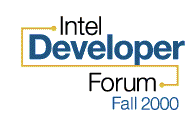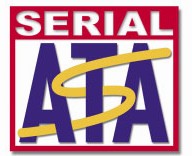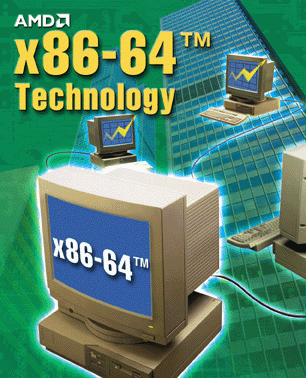
Original Link: https://www.anandtech.com/show/607
 Intel's Developer Forum, known to the rest of the computer loving world as
IDF, kicked off today with some interesting news and demonstrations. Let's take
a look at what AnandTech saw.
Intel's Developer Forum, known to the rest of the computer loving world as
IDF, kicked off today with some interesting news and demonstrations. Let's take
a look at what AnandTech saw.
The Keynote
The event officially started at 8:00am with a keynote address given jointly by Intel CEO Craig Barrett and Albert Yu, senior vice president and general manager of the Intel Architecture Group. Beginning with an introduction by Craig Barrett, the keynote quickly jumped into the importance the processor in internet business and layout, a theme that was duplicated throughout the day.
Throwing out catch phrases such as "modular Internet" and "e-Business", Barrett was quick to catch the attention of the OEM and large business companies while almost completely losing the consumer interest. It was not until Albert Yu came on stage around 9:00am PST was the real interesting stuff demonstrated and spoken about.
 |
|
Mr.
Albert Yu
|
Maintaining the flow brought about by Barrett's speech, Yu quickly moved into demonstrating just what Intel has in mind for e-business servers. The demonstration included the running of a live e-commerce application (actually nothing more than an mp3 streaming server) on clustered Itanium servers, with no data interruption when the power to one of the servers was cut on cue. Yu announced that Intel has been shipping 6,000 prototype Itanium systems and has already made 350 common business applications ready to port to the new IA-64 instruction set. If you recall from our x86-64 review last week, implementing 64-bit applications on the now delayed Itanium processor will take more than just a bit of time and is most likely part of the motivation for pushing the Itanium shipping date back from Q4 of 2000 to Q1 of 2001. Soon after the Itanium demonstration, Yu announced that 1GHz Xeon parts running on a 133MHz bus with 256KB of L2 cache were now shipping as of today. Whether these parts will be available or not has yet to be seen. Also, we have yet to see an available server platform to use with these 133MHz FSB Xeons that doesn't use RDRAM.
Yu next went to discuss the Pentium III mobile processor, making the transition from large scale servers to small notebooks. While the talk did consist of some discussion about the Pentium III's speed step technology, which allows for different CPU clock speeds and voltages when the laptop is plugged in and when it is on battery, the majority of the talk about the mobile parts seemed to be more of a competitor bash than a product description. The mobile section of Yu's talk was mostly focused on stressing how small the amount of power the CPU consumes is in comparison to the system as a whole. It seemed that Yu was mostly concerned with downplaying the issue of low power consuming laptops by showing that other system components quickly eat up much more power than the CPU itself. This may or may not be true, depending on how Intel got it's CPU power consumption, which they claimed to be as low as .85 watts when running a standard application. We know that the peak power consumption of all mobile Pentium systems is greater than this low number, suggesting that Intel is quoting power usage amounts when the CPU is essentially "asleep", like when typing in an office document. Only the release of the Transmeta processor, as well as other low voltage CPUs will tell if Intel is right about CPU power, preaching that the power of other system components (the graphics processor, for example) must be decreased before any extension of battery life is observed.
Finally, Yu went on to talk about the already announced Pentium 4 and its Net Burst technology, as we discussed in our Monday review of Net Burst. Most of what Yu described was already covered in detail in this article, but we did get to see two Pentium 4 systems in action. The first demonstration involved a 1.4GHz Pentium 4 system with 400MHz (PC800) RDRAM and involved running a "photo-realistic 3D application." Although this sounds impressive, all it proved to be was an application that looked nearly identical to the pond demo that shipped with the original GeForce256, even having the same NVIDIA logo on the bottom. Yu and the Intel employee demonstrating the product proclaimed that only the power the the Pentium 4 could produce such photo-realisitc effects. We beg to differ, as even our old Pentium 550E had no trouble running the original pond demo that shipped with the GeForce256.Along with the "power" of the Pentium 4 that was displayed with the "photo-realistic 3D application," Yu demonstrated on the fly DV to MPEG2 video decoding. This, unlike the pond demo, would prove to be rather stressful for a processor at lower speeds and without SSE2, as the demonstration proved. Running the encoding and decoding process on a Pentium III 800 proved to be a challenging task, dropping 408 frames out of the 938 sent to it. The Pentium 4 system, on the other hand, had no problem performing these highly complex calculations, capturing 938 out of 938 frames.
The final part of Yu's demonstration included showing an air-cooled Pentium 4 system running at 2.0GHz. Impressive in itself, as it proved that Moore's law still applied (it was exactly 18 months ago that Intel demoed a 1GHz system), the system was only running CPUID and nothing else. Much like the 1.5GHz Pentium 4 system demoed at last spring's IDF, it is most likely that only CPUID was run due to the fact that stressing the system with other applications would result in system instability.
HomeRF
 Next
on our must see list was a demonstration of Intel's HomeRF wireless home networking
technology. Although we will not go too in-depth about the inner workings of
HomeRF (look for that in an upcoming review of it's own), lets take a quick
glimpse at what Intel says that HomeRF can do.
Next
on our must see list was a demonstration of Intel's HomeRF wireless home networking
technology. Although we will not go too in-depth about the inner workings of
HomeRF (look for that in an upcoming review of it's own), lets take a quick
glimpse at what Intel says that HomeRF can do.
Currently running at a frequency of 2.4GHz and able to transmit at a speed of 1.6 megabits per second, HomeRF promises to change the way that your home computers and appliance interface with one another. Basically showing a few products using HomeRF technology as well as going very in-depth about the HomeRF spec, this hour-long presentation was quite interesting. It also happened to be one of the most packed tracks at the show, with people sitting on the floor and having to listen to the presentation from the hall.
As I mentioned before, this is only a small bit of what we learned during this speech. Look for a review in about a week that details this technology much more.
Serial ATA
 Another
technology that promises to change your computer and its devices inside out,
we first reported on Serial ATA (SATA) at last spring's IDF. Detailed information
of this technology can be found in that review, but for now here are
some additional things we learned at Silicon Image's demonstration.
Another
technology that promises to change your computer and its devices inside out,
we first reported on Serial ATA (SATA) at last spring's IDF. Detailed information
of this technology can be found in that review, but for now here are
some additional things we learned at Silicon Image's demonstration.
It seems that serial ATA technology is inevitable, with the limits of current parallel ATA quickly approaching. In fact, Silicon Image states that the current ATA solution, ATA100, is pretty much the limit of speed that parallel ATA can handle.
With the introduction of serial ATA, Silicon Image promises transfer rates as high as 1.5 Gb/s with the initial product release and 3 GB/s on the very near horizon. With backwards compatibility, the transition to serial ATA promises to rather smooth. Although not many more details were given that were different from our initial serial ATA preview, we did manage to snap a few pictures of serial ATA in action. Although the demo system only made it halfway through a Windows98 bootup, it proved that data was being transferred over the serial ATA bus, as well as showing that the product is far from done.
The demo unit that Silicon Image had set up included a standard parallel ATA hard drive controller, interfacing with a dongle of sorts that converted the signal to serial ATA and sent it through a very skinny cable. This cable then plugged directly into a second dongle that converted the signal back to parallel ATA which allowed it to interface with a standard hard drive. Although the data was able to travel through the cable at the serial ATA speed of 1.5 GB/s, the devices at both ends were still limited to the standard parallel ATA speeds. We have pictures of all of these setups, as well as additional information regarding serial ATA, and be sure to check back in our IDF summary for all of this information.
Intel Labs Press Event
![]() The
final IDF event we have attended thus far was an Intel Labs press event demo
session. This session demoed some of Intel's prototype technology. While none
of what we saw was final or committed to be produced, we did get to see some
interesting stuff.
The
final IDF event we have attended thus far was an Intel Labs press event demo
session. This session demoed some of Intel's prototype technology. While none
of what we saw was final or committed to be produced, we did get to see some
interesting stuff.
First off, Intel had a demonstration of computer vision technology. Although still relatively simple, the technology did allow the computer software (a game in this case) to interpret the movements of a human via an Intel web cam. In the demo, this basically allowed for the user to move his hands and the computer to follow, enabling a quick game of Simon says. Neat, but still very basic.
The next item of interest was a wireless pen demo. This technology allowed for the user to use a standard piece of paper along with a special pen and ultrasound receiver to capture notes onto a connected computer. Not only did the software allow for sketching, it also provided character recognition. Unfortunately, we were unable to try this feature of the pen as the character recognition currently only worked with Chinese characters.
The final demo of interest was what Intel called the "Voice Portal demo." This software solution allows for seamless voice recognition over a standard phone. The demo had both spoken real time stock quotes (with the user speaking the company name and the system responding with a detailed stock summary) as well as an automated e-mail system. This software allowed for the user to call in, check e-mail (with the computer reading back the e-mail over the phone), and respond to any e-mail all using voice recognition. Pretty neat, considering that Intel has plans for using such a technology with mobile phones, enabling you to "type" an e-mail while driving your car.
AMD
 The
next place we went after browsing through the Intel Labs press event actually
took us out of the San Jose convention center. We had a short meeting with the
people from AMD, where they went over their product roadmap with us, as well
as spoke to us a bit more about their x86-64 architecture that we wrote about
last week in our x86-64
Review.
The
next place we went after browsing through the Intel Labs press event actually
took us out of the San Jose convention center. We had a short meeting with the
people from AMD, where they went over their product roadmap with us, as well
as spoke to us a bit more about their x86-64 architecture that we wrote about
last week in our x86-64
Review.
AMD had nothing new to say regarding their upcoming products and basically rehashed the information that we already knew: the DDR 760 chipset will be arriving before the end of this year; the dual chip 760MP will be demonstrated in October; and the Athlon and Duron cores will soon find their way into laptops.
One thing that we did get a chance to talk about was their recently announced x86-64 Linux support. Announced last week at LinuxWorld, it seems that AMD's x86-64 architecture will have quite a few of supporters in the Linux community, meaning that the transition into 64-bit processing in the Linux server market (which consists of 10-20% of the total server market) will go quite smooth. AMD was quick to point out that in addition to Linux, many other server operating systems will support x86-64, with no names being released yet.
Final thoughts
As our first day of IDF comes to a close, we were able to get a bit of insight into not only Intel's processor future but also into the future of many other technologies. From Intel to AMD to Silicon Image, it seems that the number of people demonstrating new technology in San Jose is quite impressive. Look for further IDF coverage to continue throughout the forum.







